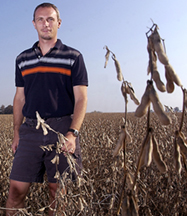
October 18, 2005
Purdue researcher leads $4.5 million NSF study of soybean genome
WEST LAFAYETTE, Ind. - Farmers, college students and consumers may benefit from soybean research made possible by a $4.5 million National Science Foundation (NSF) grant to a team of researchers headed by Purdue University plant geneticist Scott Jackson.

|
The four-year funding package launches the process to sequence the soybean genome, which eventually will provide new ways to improve crops, said Jackson, an agronomy professor and holder of the Wickersham Chair of Excellence in Agricultural Research.
Soybeans are a more than $15.1 billion business in the United States, which produces more than 2.74 billion bushels annually.
"Considering how important the soybean is economically and agriculturally, relatively little had been done to learn about its genetic makeup compared with the study of maize and rice," Jackson said. "Soybeans, which are legumes, are much different than rice and corn, which are both cereal plants. Soybeans can do things that neither corn nor rice do."
The researchers will locate the genes on the soybean chromosomes in order to create a physical map, Jackson said. Integrating the physical map with the parts of the genetic map already available eventually will allow sequencing of the entire soybean genome.
The soybean has many duplications of DNA in its genome, so Jackson and his collaborators are targeting five regions that have structural duplications to determine the functional similarities of each region. Jackson and his colleagues also will compare gene function in those duplicated areas. Understanding how the soybean duplications evolved will ease the task of sequencing the soybean genome and also give the scientists information about the plant's structural evolution.
"It looks like the soybean has gone through two rounds of duplicating the original genome," Jackson said. "So the first duplication resulted in two copies of an original gene, and then it duplicated again resulting in four copies.
"These duplications raise a whole slew of questions about how these genes function. Some of them may be shut off, others still may be active, and others may have assumed new roles."
Almost all organisms' genomes, including humans, have some duplications, so studying this process in soybeans provides information that is broadly applicable, Jackson said.
Funding from the United Soybean Board enabled Jackson's research team to turn the soybean genome into a giant jigsaw puzzle so small bits could be prepared for sequencing, which is the determination of the order of the base pairs that comprise DNA. Because of the technology used for sequencing, the genome had to be broken down into tens of thousands of smaller pieces that are then cloned before each piece can be sequenced.
"The long-term goal of this grant is to assemble those pieces back into the whole genome," Jackson said. "We have a whole freezer full of these little pieces. The preliminary sequencing that we're doing now is just to get an idea of the gene landscape."
When the whole genome is sequenced, researchers will be able to pick plants based on their genetic makeup that are resistant to such things as drought, sudden death syndrome, soybean rust and other factors that negatively impact soybean production. They also hope to find out how soybeans, unlike corn and rice, do such things as put nitrogen back into the soil to improve it.
"Soybeans interact with soil, bacteria and fungi to fix nitrogen," Jackson said. "We suspect that soybeans have a bunch of genes not in rice or maize. The gene interaction allows the microbes to enter the plant so that plants and microbes jointly put the nitrogen in the soil. This is important for the following year's corn crop and something that only legumes can do."
Eventually scientists may be able to improve other plants so they can add nitrogen to soil.
The preliminary soybean sequencing research under the NSF grant also has a broad impact on the education of some college students. Each summer as the scientists work toward mapping the entire soybean genome, Native American and Hispanic undergraduate students from non-research schools and their academic advisers will work in the laboratories of one of the five project collaborators.
"This will give these students and their teachers a chance to learn the latest research techniques and interact with graduate students, postdoctoral students and the principal investigators on the soybean genome," Jackson said.
Researchers working with Jackson include Randy Shoemaker of the U.S. Department of Agriculture/Agricultural Research Service at Iowa State University, Bill Beavis of the National Center for Genomic Resources, Gary Stacey of the University of Missouri and Rod Wing of the University of Arizona. Jackson also is a member of the Purdue Genomics Center.
Writer: Susan A. Steeves, (765) 496-7481, ssteeves@purdue.edu
Source: Scott Jackson, (765) 496-3621, sjackson@purdue.edu
Ag Communications: (765) 494-2722;
Beth Forbes, forbes@purdue.edu
Agriculture News Page
Related Web sites:
Purdue Department of Agronomy
USDA/Agricultural Research Service
PHOTO CAPTION:
Purdue plant geneticist Scott Jackson and a research team have received a $4.5 million National Science Foundation grant for work aimed at sequencing the soybean genome. The genome eventually will provide information to improve crops. (Purdue Agricultural Communication photo/Tom Campbell)
A publication-quality photo is available at https://www.purdue.edu/uns/images/+2005/jackson-soygenome.jpg
To the News Service home page